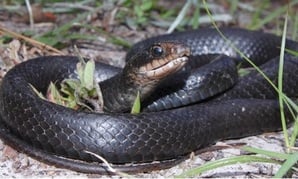Southern Black RacerColuber constrictor priapus |

Custom Search
|
|
The Southern Black Racer snake (Coluber constrictor priapus) is a very common non-venomous snake species found in and around the southern regions of the United States. It's widely spread throughout the Florida mainland and also the Florida keys. Outside of Florida, it can also be found throughout the Eastern regions of the US, from NE Texas.
These non-venomous snakes are mainly found in grasslands, prairies, scrub, bushy areas and sandy hills. The species is also known as the black runner snake. These snakes are shy and timid by nature and are in most cases harmless, if not attacked or threatened. Although its bite is harmless, their needle-sharp teeth can inflict bleeding upon its victim. The average size of an adult Southern black racer snake is around 20 to 56 inches, although the maximum length of an adult snake can reach approximately 70 inches. They can live up to 10 years both in the wild or in captivity. These snakes have a slim body, covered with 17 rows of dorsal smooth scales down the middle of their body.The southern black racer snake is marked with dull colors covering all of its body. Their dorsal side is black in contrast with their gray belly and a distinctive white jawline and throat. The juveniles are usually gray in color, with some clear reddish brown blotches, that fade into their solid-colored tail. As for their vision, this snake is considered to be color blind.

These snakes can move extremely fast, hence the name "racer". They need to because they are typically daytime hunters and need to escape predators.
They are also capable of gliding, swimming, and climbing at unbelievable speeds. They are very skilled swimmers and amazing opportunistic predators. Their speed is possible because of their natural smooth skin and scales, they usually shed their skin once a year. The southern black racer snakes have several predators, such as hawks and other birds that prey upon these snakes, sometimes even domestic dogs or cats become predators to them. Like other snake species, the southern black racers use underground shelters to hibernate during the coldest winter months, from around late October, emerging again in mid-March. They hibernate in large groups of snakes and with other species too. They use rock crevices or old burrows, the snake basks outside of the den for weeks beforehand and can often use the same den for years. The southern black racer has a very unique defensive mechanism. When in danger, the snake will vibrate its tail in dense grass generating a vibrating sound, which sounds somewhat similar to the sound created the rattlesnake's tail. Although these snakes share some common characteristics to constrictor snakes, the scientific name ‘constrictor’ given to them is a bit misleading. Since these snakes display little signs of behavior which give a constrictor like the burmese python its name. In fact, black racers don't coil around their preys to suffocate and kill them before devouring them. Diet / Feeding The southern black racer snake hunts down mainly rodents, like rats, insects, other small snakes like the slender rough green snake, moles, lizards, frogs and toads, and on occasion even birds or bird's eggs. When compared with other snakes they have a big appetite. Their diet habits are beneficial to humans since they prey mostly upon such animals, that are actually a menace to our crops. Reproduction The species mating season is the springtime, mostly between late April and mid-June. The breeding season extends from the month of June to early July. The males become sexually mature at the age of 1 or 2 years, whereas the female southern black racer reaches their sexual maturity later between 2 and 3 years. The female can give birth anywhere from between 3 and 32 babies. After birth, the juveniles are approximately 6 inches long. The adult snakes do not feed the babies or even protect them. For the baby southern black racers to survive they use the process of camouflage. Even so, the juveniles have a survival rate of only around 40%, which means that, in general, only about 8 babies survive through the first year of their life. Conservation / Threats Humans are as with most snakes the biggest threat to the southern black racer. They are killed in large numbers by cars or are killed out of fear, even by mistake because of their close resemblance to a dangerous venomous snake, the Water Moccasin. This snake is present in the IUCN Red List under the ‘least concern’ status. The species pretty abundant in some areas. However in the Canadian province of Ontario, they are legally protected, because of the gradual decrease in their numbers, The species has also become somewhat uncommon in Michigan. As a pet, the southern black racer cannot be considered a good choice because of their nervous disposition they generally do not tolerate handling.
|
Did You Know?
The Mojave rattlesnake venom is the most toxic of any rattlesnake because of the highly neurotoxic "Mojave toxin". Scientific classification |
© 2014 Snake Facts About Us | Privacy Policy | Contact




